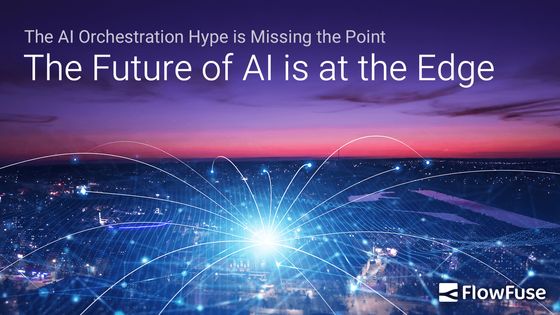The AI Orchestration Hype is Missing the Point. The Future of AI is at the Edge.
While the market celebrates cloud orchestration, the real innovation is happening at the edge.

Congratulations to n8n on their Series C funding round! This is a fantastic milestone and a clear signal that the market has moved beyond AI experimentation and into the serious business of production deployment. Platforms like n8n are mastering what we call centralized orchestration: creating cloud-native "brains" that connect digital services, APIs, and data sources to execute complex workflows. This is a crucial step forward for automating tasks within the digital realm.
But it's only Act One.
The tech world is buzzing with talk of AI agents and orchestration platforms, and the energy around n8n's recent funding is proof of this momentum. This energy is a fantastic sign of a maturing market, proving that we've moved beyond AI experimentation and into the serious business of production deployment.
For the industries that power our physical world—manufacturing, logistics, energy, and infrastructure—a centralized, cloud-dependent brain isn't just inefficient; it's a non-starter. The real challenges, and the greatest opportunities, don't live in the cloud. They live at the edge.
The Cloud's Achilles' Heel: The Physical World
When your operations involve real-world assets like factory machinery, remote sensors, or logistics fleets, the centralized orchestration model reveals its fundamental limitations. This dependency on a remote server introduces critical vulnerabilities. For industrial applications where milliseconds matter, the latency of a cloud round-trip is too slow for making urgent decisions, like shutting down a malfunctioning machine. An unstable or lost internet connection severs the link completely, leaving the AI brain cut off from its body and rendering edge operations blind. Beyond the physical connection, there is the issue of cost and data gravity. Streaming continuous data from thousands of sensors to the cloud for processing is not only prohibitively expensive but also inefficient, as the principle of data gravity dictates that processing should occur as close to the source as possible. Finally, a cloud-first model presents significant security and compliance challenges, as many industries require sensitive operational data to remain on-premise for sovereignty and safety.
The Next Paradigm: A Distributed Nervous System for Industry
The future of industrial AI is not a single, all-knowing brain in the cloud. It’s a distributed nervous system—a network of localized, intelligent nodes that can sense, reason, and act directly at the edge. This is a fundamental architectural shift from orchestration to decentralized intelligence. In this paradigm, AI lives where the data is generated. This shift enables real-time decision-making, allowing agents at the edge to instantly manage predictive maintenance or autonomous quality control. Such a model is inherently more resilient, as edge devices operate intelligently without a constant cloud connection, ensuring core processes never fail. This local processing also leads to a more efficient and scalable infrastructure by minimizing costly data transfers to the cloud.
FlowFuse: Built for the Edge-Native Future
While the market celebrates tools for building digital AI agents, FlowFuse has been dedicated to building the industrial-grade nervous system that connects them to the physical world. Built on the proven foundation of Node-RED, our platform provides engineers with a single control tower to securely manage fleets of thousands of Node-RED instances at scale. This capability allows them to seamlessly fuse the physical and digital, collecting and acting upon industrial data right at the source. Furthermore, we empower every engineer with the FlowFuse AI Assistant, a tool that simplifies the creation and management of complex edge logic, removing the need for specialized data science skills. Soon, with our upcoming dedicated AI Agent nodes, FlowFuse will not only connect the edge to the cloud but will enable powerful AI agents to run natively at the edge, completing the vision for a truly distributed intelligent system.
Conclusion: Look Beyond the Cloud
The rise of AI orchestration platforms is an important part of the industry's evolution. But for those of us solving problems in the physical world, it's a stepping stone, not the destination. Choosing the right platform comes down to the world you operate in. If you are building AI agents for purely digital applications, the cloud-centric tools are a great fit. But if you need to bring intelligence to your factory floors, your supply chains, and your critical infrastructure, you need a platform architected for the unique challenges of the edge. You need to build not just a brain, but a complete nervous system.
Ready to Build the Future of Industrial AI?
FlowFuse is built for the challenges of industrial and IoT data. Whether you're implementing Industry 4.0 initiatives or building predictive maintenance systems, we provide the platform to deploy and manage intelligence at the edge.
About the Author
Pablo Filomeno
Product Marketing Manager
Pablo is the Product Marketing Manager of FlowFuse. With a background in strategic communications and a passion for making complex technologies accessible, his mission is to help industrial and software teams discover the power of FlowFuse to transform their operations.
Related Articles:
- The Node-RED Revolution: How Low-Code is Democratizing Industrial Automation
- Download and Install Node-RED for Production
- Winning Through Open-Source Software in Manufacturing Digitalization
- Curated Node-RED Integrations: FlowFuse Certified Nodes 2.0
- Announcing Node-RED Con 2025: A Community Conference on Industrial Applications